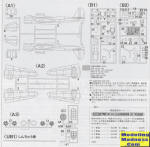
Hasegawa 1/72 Ki-48-II (Lily) 'Special Equipment'
| KIT #: | 02287 |
| PRICE: | 2600 yen |
| DECALS: | One option |
| REVIEWER: | Scott Van Aken |
| NOTES: | 2018 Limited edition |

| HISTORY |
The development of the aircraft began at the end of 1937 at the request of the Japanese military high command. Kawasaki received an order to develop a "high-speed bomber" capable of 480 km/h (300 mph) at 3,000 m (9,840 ft), and able to reach 5,000 m (16,400 ft) within 10 minutes. It was inspired by the Soviet Tupolev SB.
Kawasaki had the advantage of the experience of designing the Ki-45 twin-engined heavy fighter. Most technical problems were solved; however the aircraft had a number of shortcomings. It carried only an 800 kg (1,760 lb) bombload. This was actually more than contemporary light bombers such as the Bristol Blenheim or Tupolev SB, and only slightly less than light bombers designed several years later, such as the A-20 Havoc, and the strikingly similar-appearing Martin Maryland and Baltimore. Speed was intended to be its primary defense, much like the later, unarmed, De Havilland Mosquito. So it had only three machine guns (again, an equivalent armament to contemporary light bombers). This made it very vulnerable to enemy fighters later in the war, once they became fast enough to actually catch it. The flight characteristics of the Ki-48 also left much to be desired. Newer generations of Allied fighters caught up in speed, and eventually, the Ki-48 was too slow to outrun them, while superior modern Japanese aircraft, such as the Yokosuka P1Y and the Mitsubishi Ki-67, could only be produced in small numbers. The first versions were lightly armoured, so the Ki-48 was quite aerobatic, and could loop and turn with an experienced pilot at the controls. The aircraft was often used as a dive bomber in Burma. The aircraft was not necessarily a failure, and was considered an acceptable light bomber for the first few years of the war by many historians. Much like the Mitsubishi A6M Zero fighter, it was satisfactory for the period when it was designed and produced, but had to be used against much newer and faster competition, due to Japan's inability to produce enough newer aircraft.
| THE KIT |
 This kit allows you to build a 'special equipment test aircraft. Actually, that
should be 'special attack' as apparently the nose probes were designed to set of
bombs in the bomb bay of the aircraft during a kamikaze attack. I really had to
dig to find this info as the instructions don't really mention much about it and
only offer a standard history.
This kit allows you to build a 'special equipment test aircraft. Actually, that
should be 'special attack' as apparently the nose probes were designed to set of
bombs in the bomb bay of the aircraft during a kamikaze attack. I really had to
dig to find this info as the instructions don't really mention much about it and
only offer a standard history.
The additional bits added to the kit are nothing more than a bronze rod that you cut into the appropriate length and then place in holes you have drilled into the nose of the aircraft. The rest of the kit is the standard Hasegawa/Mania kit that has been available for decades. The kit itself isn't bad, but it is 70s technology even if it does have recessed panel lines. You get a nicely done interior for the scale and you are provided with a decal for the instrument panel. No crew is provided as Mania did not offer these. This variant was unarmed as befits a 'test' aircraft so you can leave off the guns unless you buy the kit to do a standard Ki-48 using aftermarket decals.
You do have to open and fill some holes in the kit,
but the instructions show you just what you need to do. Engine cowlings are two
side panels with a single cowling front so no worries about seams. Landing gear
is nicely done and can be installed after everything is painted. I would highly
recommend that you obtain a set of canopy masks for this as there are many panes
to mask. There are two options. One has three of these rods protruding from the
nose and one only has a single rod.
Instructions are standard Hasegawa fare with two options. Both have olive green upper surfaces with grey wing and tailplane undersides. One has a solid green fuselage while the other has the usual grey undersides and a while fuselage stripe. Both were with the BANDA special attack group. With no unit markings, you get a nicely done decal sheet with just standard markings.
| CONCLUSIONS |
Not exactly the most colorful IJAAF plane, but an interesting one due to its intended use. There are aftermarket markings for the Ki-48 if you look for them and that might be an option for several of you regarding this kit. Here is what info I have found on the BANDA special attack group:
Banda Unit (万朶隊,, Banda-tai)Original unit; Hokota Instructing Flying Division
12 November 1944
15 November 1944
20 December 1944
| REFERENCES |
https://en.wikipedia.org/wiki/Kawasaki_Ki-48
February 2021 Copyright ModelingMadness.com.
All rights reserved. Thanks to me for finding this one on sale. If you would like your product reviewed fairly and
fairly quickly, please
contact
the editor
or see other details in the
Note to
Contributors.
Back to the Main Page
Back to the Review
Index Page
Back to the Previews Index Page